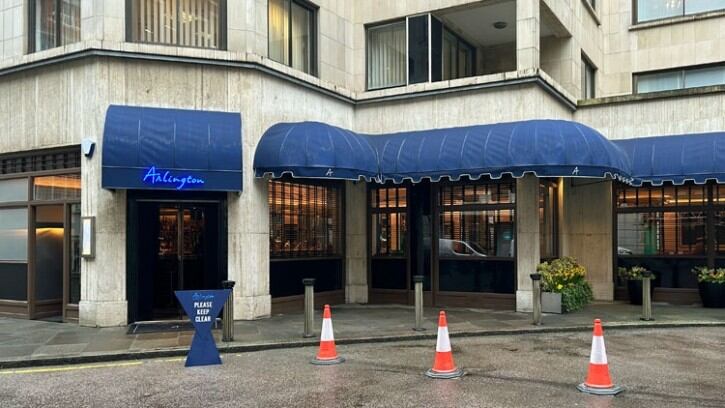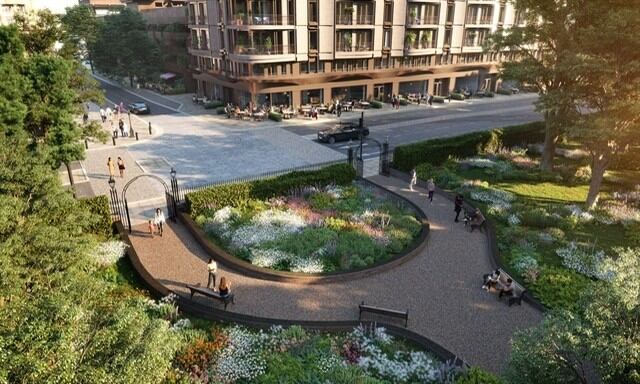There are many tell-tale signs that you are in a Jeremy King restaurant. The scale is one, with the restaurateur known for opening grand dining rooms that have included Brasserie Zédel, The Delaunay, and The Wolseley, and the unmistakeable hum of the dining room is another. But at The Park, King’s newly-opened restaurant in Queensway, there is another clue that’s right under your nose. Take a sip from one of its delicate water glasses and you’ll see engraved on the bottom the initials RB JK - RB standing for British tableware designer Richard Brendon, and JK for, well, you don’t need me to tell you that.
It’s a subtle touch, but the kind one has come to expect from King, a man known for his fastidious attention to detail. I meet with him at The Park while it is still undergoing friends and family softs - or the guinea pig process as he calls it - and the attention to detail is palpable - and audible, as a sound technician painstakingly tests the restaurant’s speaker system. It is one of the hottest days of the year and we are sat in the corner area of the bar, the light streaming through The Park’s huge floor to ceiling windows, but this doesn’t stop King from ordering himself a hot chocolate (with oat milk) although he has allowed himself the luxury of removing his suit jacket - a rare instance when I have not seen the urbane restaurateur fully suited.
I’m here to talk about the new restaurant King is in the throes of opening in the new Park Modern building located on the corner of Bayswater and Queensway. I’m not here to rake over the past few years of King’s (well documented) departure from his restaurant group that was then Corbin & King, not least because many lines have already been dedicated to this, or to discuss Arlington, the restaurant located on the former site of Le Caprice, which King and former business partner Chris Corbin opened in 1981, but inevitably both crop up in the conversation. While King is also set to relaunch Simpson’s in the Strand early next year, for me it is The Park in all its gleaming newness that is the most captivating of the Jeremy King story of the past few years.
“Quite a few people said I was very brave to come back, but I don’t consider it to be bravery,” he replies to the obvious question of why the new project. “If you do what you feel is the best thing it’s not bravery. I wanted to do restaurants again, but I never predetermine what anything will be.
“One of the great failings with restaurants is there are too many people who are driven by investors and performance and the need to go round London looking for a venue to put a concept into. That is why it often goes wrong. I work on the basis that I look for nice spaces and go from there.”
IN THE CASE OF THE PARK IT WAS LOVE AT FIRST SIGHT, with King eventually agreeing to pay it a visit after initially turning down the opportunity. He saw the new build as a concrete shell, but even with the windows covered with vinyl he knew it was the one.
“I knew immediately what the look and feel of it would be. My background is in brasseries and grand cafes that are 100 years old or so, because I’m inspired by buildings. Here for the first time, I could create a contemporary grand café for the early 21st century rather than the 20th century. It immediately came to life.”
With its light wood panelling throughout, light leather seating and modernist lighting The Park is certainly a different proposition to King’s fin de siècle style brasseries but is no less striking. “The moment I called it The Park, it then made me feel that it was more American in feel,” he continues. “And then the way my mind was working was if it was American, if I were Danny Myer or Jonathan Waxman, and I had this space on Central Park, what sort of restaurant would it be?”
“One of the great failings with restaurants is
there are too many people who are driven by investors"
The answer is a restaurant he describes as a “love letter to east coast of America with west coast influence”, in part inspired by the farm-to-table movement in the US pioneered by the likes of Alice Walters and Larry Forgione, who King says took a moribund cuisine and brightened it up with simple, ingredient-led cooking. “I’ve become impressed by simplicity; the kind of cooking Simon Hopkinson was doing at Hilaire. It’s quasi Cal-Ital simple food - grills, salad, seafood that I knew would suit this place.”
With the design, he has opted for a luxurious feel. “Too often restaurants are thrown together out of catalogues. I like working with the designers on chairs, and banquettes. One of the things I find fundamental is you have to create the restaurant that you want to go to yourself. Too often they are formulaic.”
He says one of the things he likes in a restaurant is a corner seat and a booth, of which restaurants tend not to have many. It turns out, he’s something of a booth buff. King made a point of creating 14 booth or corner dining areas when designing Viennese café Fischer’s and says he knows how many similar areas are in modern French brasserie Maison Francois (it’s 17). At The Park he’s gone bigger still, with a total of 30 areas. You get fewer tables this way, but with The Park having space for 150 covers plus a downstairs PDR, a lack of covers is unlikely to be a problem.

ARLINGTON SITS APART FROM KING’S PREVIOUS OPENINGS, BUT THE PARK FEELS LIKE A JEREMY KING RESTAURANT in the same way that The Wolseley or The Delaunay does. Is he concerned that people might consider it to be part of the renamed The Wolseley Hospitality Group (TWHG) because of some inevitable similarities?
He dismisses this as just life. “For years after Chris and I left the Beaumont Hotel (the pair relinquished the management of Mayfair hotel in 2018 after its sale to the Barclay family) people would come up to me and said they’d just stayed at my hotel, and I’d say, ‘you didn’t’. A lot of people are still confused.”
While on the topic of TWHG, how does he regard the business of the past few years now that’s he sitting in his new brand restaurant. The group is owned by Minor International, which rebranded it from Corbin & King following a prolonged and very public battle for ownership with King, who was ousted in the process. Are there any regrets?
He is philosophical. While he no doubt still bears the scars of what he has previously described as a “war” and being "under siege", bathed in sunlight and sat in a beloved corner space, he seems to have found peace with the past. “I’ve been asked, how did I feel about seeing places I or Chris created being turned into chains (a second The Wolseley has opened in the City, and the group has hinted of further The Wolseley sites in Hong Kong, Singapore and Shanghai in the coming years)? Did I regret that I didn’t do it? Absolutely not. It’s not my strength. It’s not what I do.”
His biggest takeaway from the Minor debacle, he says, has been about control. “The thing it has taught me more than anything else is that I have to have control. And I did have control in many ways, but anybody who owns a majority stake thinks they own it.” To overcome this problem with his new business, King says each restaurant has individual investors, although some have invested in more than one. “I like that, it’s a bit more of a club.”
DESPITE HIS CALM EXTERIOR, PHLEGMATIC DISPOSITION, and a significant career in restaurants that spans more than 40 years, King admits to having the same nerves as every restaurateur as the opening date for any new project looms large. “Of course, I always have doubts, particularly in the run up to opening a restaurant,” he says. “When opening Arlington I asked myself whether it was what people want or whether I was making a terrible mistake. I rebuilt it in the style of 80s and 90s when I and Chris owned it and wondered whether people were going to say I should have moved on. I am constantly worrying whether I’ve got everything right or not, but not whether I was right to do it.”
One of the devices he uses to second guess any potential criticism is to write reviews of his own restaurant. For Arlington, he lasered in on the addition of smoked salmon to the menu, questioning how people would react to it at ‘one of the most eagerly anticipated openings of the year’, as the review goes. It could have gone either of two ways, he muses - a precursor to even more disappointment or a Eureka moment for the diner when they realise this was what the restaurant had been missing for all these years. It is then up to the restaurant to decide its own fate.
"People see me in the restaurant on a Saturday night
and ask me why I’m there. Because the easy way
to do restaurateuring is the hard way"
More importantly than the smoked salmon, however, is the restaurant’s raison d’etre. King is adamant he does not open a restaurant for a restaurant’s sake, whether that be one that harks back to his early career or one that looks forwards. “I want it to be justifiable. A restaurant needs to know what it is, because if it doesn’t then how are the customers going to know? Yes, you can build a restaurant out of fashion, but you can’t build a restaurant with heart and soul that way. I have been offered spaces in New York that would be inappropriate to put a restaurant in. You only have to look at the popularity of places like Bouchon Racine or Josephine, they feel real.”
At this point his train of thought goes back to when he took on the J. Sheekey site in Covent Garden in 1998, which he uses as a good example of a restaurant having the right feel. At the time he had charged property agent David Coffer with finding him a site of 7,500 to 10,000sq ft over one floor with one large room and 60/40 front-of-house to back-of-house split. He recalls telling Coffer to call off the search on finding J. Sheekey. “Sheekey is less than 4,000sq ft, is over two floors and has five rooms - what are you fucking talking about?’” is how King describes Coffer's reaction. His response? “I like it, it feels good.”

FORTY YEARS IN THE BUSINESS IS A LONG TIME, particularly when the last couple have been so eventful for all the wrongs reasons, but King seems very much at ease. Known for his openness, his regular email updates have given a warts and all account of The Park’s progress, with the restaurateur breaking the fourth wall with images of unfinished dining rooms, exposed cables, and unsightly holes dug up on the street outside the restaurant. In one recent email, titled ‘limbering up’ he shares updated photos of the still-to-be-completed staircase that has been something of a headache. Like a new parent opening up about their child’s sleepless nights or teething troubles, these are very personal and human insights into what it takes to open a restaurant.
The length and tone of these email missives also suggests that King hasn’t lost any of his spark with new openings. Is he still having fun?
“Definitely,” is the considered response. “Having had the incredible luxury of some time off to observe what was happening in business and getting some sort of clarity has made it so much better. I am keen to empower people and to properly delegate. I control the look and so on but I’m enjoying working with people, whether it’s the management, the team, or the designer. I’m much more relaxed and open about what we’re doing.”
“Quite a few people said I was very brave to
come back, but I don’t consider it to be bravery"
He shares some wisdom that was imparted by a friend in advertising that has helped this process. Seeking advice on restructuring and leadership issues, King was told that it was all about delegation, advice he considered to be a bit of a cop out. But it was more specific. “He told me to never ever delegate anything whatsoever to anyone at all unless you have complete and utter confidence in their ability to do the task. We will appoint somebody as a manager so they should be able to do it, but often we set people up to fail. In the back of my mind if I’m appointing somebody now, I revel in their ability to do that job and, if anything, I can learn from them. That was a massive emancipation for me.”
Being able to delegate doesn’t mean a dereliction of duty, and King remains a presence on the dining room floor, which has become another of his trademarks. “People see me in the restaurant on a Saturday night and ask me why I’m there. Because the easy way to do restaurateuring is the hard way. I’ve said this many times before, but restaurateurs run a restaurant from the floor, owners from the board room, and you can tell the difference.”
THERE IS MORE RESTAURATEURING ON THE HORIZON. When King announced his return to the restaurant scene last year with news of The Park it was followed quickly by details of Arlington and of his relaunch of Simpson’s in the Strand. Opening three restaurants in quick succession (although the opening of Simpson’s has now been delayed until the start of next year) might seem like a display of chutzpah, but this is not King’s first rodeo when it comes to opening a trio of places within a short time frame. He recalls the opening of Zédel, The Delaunay and Colbert within 10 months, with their various gestation periods ranging from a year to eight years. Zédel took one and a half years to open, The Delaunay around two years, with Colbert taking significantly longer.
“I liked the idea of taking on the old Caprice site, but I needed another project, The Park, which took longer to build. Then it felt interesting. I love this portfolio because Arlington is all about history whereas The Park is brand new, and Simpson’s is 200 years old. That’s very appealing.”
Details of the relaunched Simpson’s are still scarce (more will no doubt be revealed in an email from King in the coming months), but the intention is to create a modern version of what Simpson’s always was. In its heyday, it was famous for its roast dinners that were wheeled around on silver platters and carved tableside. Diners have included Charles Dickens and prime ministers Winston Churchill, Benjamin Disraeli and William Gladstone. Last year it was announced that Simpson’s symbolic carving trolleys (pictured below) were to be auctioned off alongside its crockery, furniture, and chandeliers, but an intervention by King means that they will feature in the restaurant’s reboot.

“There will be lots of trolley work,” he insists. “For carving and desserts, but we are even going to expand on the trolleys because a lot of people are asking about them.”
The main restaurant will remain very much as is, but with a modern touch, while upstairs will be a diffusion restaurant described as being more accessible and affordable. King also intends to revive the restaurant’s basement bar, which he says has a very late licence. “We want to get the theatre people back in. It always was a theatre restaurant.”
With so much going on, is it churlish to ask what next? He’s not surprised by the question and hints he has more up his sleeve. “Somebody showed me something really interesting which I’m looking at,” he teases, “although I’m not quite sure on the timings.”
Jeremy King is well and truly back.


